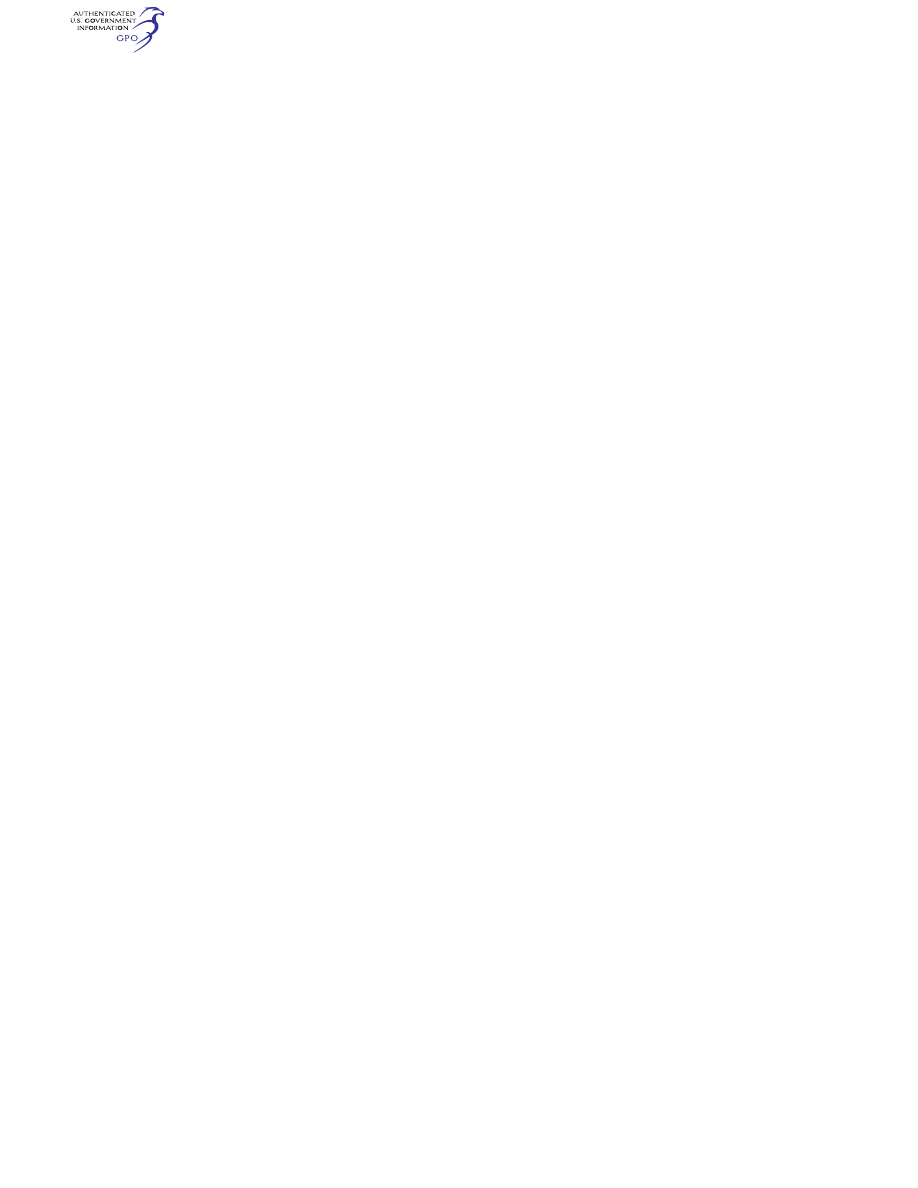
119
Federal Aviation Administration, DOT
§ 121.310
E
DITORIAL
N
OTE
: For F
EDERAL
R
EGISTER
ci-
tations affecting § 121.309, see the List of CFR
Sections Affected, which appears in the
Finding Aids section of the printed volume
and at
www.govinfo.gov.
§ 121.310 Additional emergency equip-
ment.
(a)
Means for emergency evacuation.
Each passenger-carrying landplane
emergency exit (other than over-the-
wing) that is more than 6 feet from the
ground with the airplane on the ground
and the landing gear extended, must
have an approved means to assist the
occupants in descending to the ground.
The assisting means for a floor-level
emergency exit must meet the require-
ments of § 25.809(f)(1) of this chapter in
effect on April 30, 1972, except that, for
any airplane for which the application
for the type certificate was filed after
that date, it must meet the require-
ments under which the airplane was
type certificated. An assisting means
that deploys automatically must be
armed during taxiing, takeoffs, and
landings. However, if the Adminis-
trator finds that the design of the exit
makes compliance impractical, he may
grant a deviation from the requirement
of automatic deployment if the assist-
ing means automatically erects upon
deployment and, with respect to re-
quired emergency exits, if an emer-
gency evacuation demonstration is
conducted in accordance with
§ 121.291(a). This paragraph does not
apply to the rear window emergency
exit of DC–3 airplanes operated with
less than 36 occupants, including crew-
members and less than five exits au-
thorized for passenger use.
(b)
Interior emergency exit marking.
The following must be complied with
for each passenger-carrying airplane:
(1) Each passenger emergency exit,
its means of access, and its means of
opening must be conspicuously
marked. The identity and location of
each passenger emergency exit must be
recognizable from a distance equal to
the width of the cabin. The location of
each passenger emergency exit must be
indicated by a sign visible to occupants
approaching along the main passenger
aisle. There must be a locating sign—
(i) Above the aisle near each over-
the-wing passenger emergency exit, or
at another ceiling location if it is more
practical because of low headroom;
(ii) Next to each floor level passenger
emergency exit, except that one sign
may serve two such exits if they both
can be seen readily from that sign; and
(iii) On each bulkhead or divider that
prevents fore and aft vision along the
passenger cabin, to indicate emergency
exits beyond and obscured by it, except
that if this is not possible the sign may
be placed at another appropriate loca-
tion.
(2) Each passenger emergency exit
marking and each locating sign must
meet the following:
(i) Except as provided in paragraph
(b)(2)(iii) of this section, for an air-
plane for which the application for the
type certificate was filed prior to May
1, 1972, each passenger emergency exit
marking and each locating sign must
be manufactured to meet the require-
ments of § 25.812(b) of this chapter in ef-
fect on April 30, 1972. On these air-
planes, no sign may continue to be
used if its luminescence (brightness)
decreases to below 100 microlamberts.
The colors may be reversed if it in-
creases the emergency illumination of
the passenger compartment. However,
the Administrator may authorize devi-
ation from the 2-inch background re-
quirements if he finds that special cir-
cumstances exist that make compli-
ance impractical and that the proposed
deviation provides an equivalent level
of safety.
(ii) For a transport category airplane
for which the application for the type
certificate was filed on or after May 1,
1972, each passenger emergency exit
marking and each locating sign must
be manufactured to meet the interior
emergency exit marking requirements
under which the airplane was type cer-
tificated. On these airplanes, no sign
may continue to be used if its lumines-
cence (brightness) decreases to below
250 microlamberts.
(iii) For a nontransport category
turbopropellerpowered airplane type
certificated after December 31, 1964,
each passenger emergency exit mark-
ing and each locating sign must be
manufactured to have white letters 1
inch high on a red background 2 inches

120
14 CFR Ch. I (1–1–24 Edition)
§ 121.310
high, be self-illuminated or independ-
ently, internally electrically illumi-
nated, and have a minimum brightness
of at least 160 microlamberts. The color
may be reversed if the passenger com-
partment illumination is essentially
the same. On these airplanes, no sign
may continue to be used if its lumines-
cence (brightness) decreases to below
100 microlamberts.
(c)
Lighting for interior emergency exit
markings.
Except for nontransport cat-
egory airplanes type certificated after
December 31, 1964, each passenger-car-
rying airplane must have an emergency
lighting system, independent of the
main lighting system. However,
sources of general cabin illumination
may be common to both the emergency
and the main lighting systems if the
power supply to the emergency light-
ing system is independent of the power
supply to the main lighting system.
The emergency lighting system
must—
(1) Illuminate each passenger exit
marking and locating sign;
(2) Provide enough general lighting
in the passenger cabin so that the aver-
age illumination when measured at 40-
inch intervals at seat armrest height,
on the centerline of the main passenger
aisle, is at least 0.05 foot-candles; and
(3) For airplanes type certificated
after January 1, 1958, after November
26, 1986, include floor proximity emer-
gency escape path marking which
meets the requirements of § 25.812(e) of
this chapter in effect on November 26,
1984.
(d)
Emergency light operation.
Except
for lights forming part of emergency
lighting subsystems provided in com-
pliance with § 25.812(h) of this chapter
(as prescribed in paragraph (h) of this
section) that serve no more than one
assist means, are independent of the
airplane’s main emergency lighting
systems, and are automatically acti-
vated when the assist means is de-
ployed, each light required by para-
graphs (c) and (h) of this section must
comply with the following:
(1) Each light must—
(i) Be operable manually both from
the flightcrew station and, for air-
planes on which a flight attendant is
required, from a point in the passenger
compartment that is readily accessible
to a normal flight attendant seat;
(ii) Have a means to prevent inad-
vertent operation of the manual con-
trols; and
(iii) When armed or turned on at ei-
ther station, remain lighted or become
lighted upon interruption of the air-
plane’s normal electric power.
(2) Each light must be armed or
turned on during taxiing, takeoff, and
landing. In showing compliance with
this paragraph a transverse vertical
separation of the fuselage need not be
considered.
(3) Each light must provide the re-
quired level of illumination for at least
10 minutes at the critical ambient con-
ditions after emergency landing.
(4) Each light must have a cockpit
control device that has an ‘‘on,’’ ‘‘off,’’
and ‘‘armed’’ position.
(e)
Emergency exit operating handles.
(1) For a passenger-carrying airplane
for which the application for the type
certificate was filed prior to May 1,
1972, the location of each passenger
emergency exit operating handle, and
instructions for opening the exit, must
be shown by a marking on or near the
exit that is readable from a distance of
30 inches. In addition, for each Type I
and Type II emergency exit with a
locking mechanism released by rotary
motion of the handle, the instructions
for opening must be shown by—
(i) A red arrow with a shaft at least
three-fourths inch wide and a head
twice the width of the shaft, extending
along at least 70
°
of arc at a radius ap-
proximately equal to three-fourths of
the handle length; and
(ii) The word ‘‘open’’ in red letters 1
inch high placed horizontally near the
head of the arrow.
(2) For a passenger-carrying airplane
for which the application for the type
certificate was filed on or after May 1,
1972, the location of each passenger
emergency exit operating handle and
instructions for opening the exit must
be shown in accordance with the re-
quirements under which the airplane
was type certificated. On these air-
planes, no operating handle or oper-
ating handle cover may continue to be
used if its luminescence (brightness)
decreases to below 100 microlamberts.

121
Federal Aviation Administration, DOT
§ 121.310
(f)
Emergency exit access.
Access to
emergency exits must be provided as
follows for each passenger-carrying
transport category airplane:
(1) Each passage way between indi-
vidual passenger areas, or leading to a
Type I or Type II emergency exit, must
be unobstructed and at least 20 inches
wide.
(2) For each Type I or Type II emer-
gency exit equipped with an assist
means, there must be enough space
next to the exit to allow a crewmember
to assist in the evacuation of pas-
sengers without reducing the unob-
structed width of the passageway below
that required in paragraph (f)(1) of this
section. In addition, all airplanes man-
ufactured on or after November 26, 2008
must comply with the provisions of
§§ 25.813(b)(1), (b)(2), (b)(3) and (b)(4) in
effect on November 26, 2004. However, a
deviation from this requirement may
be authorized for an airplane certifi-
cated under the provisions of part 4b of
the Civil Air Regulations in effect be-
fore December 20, 1951, if the Adminis-
trator finds that special circumstances
exist that provide an equivalent level
of safety.
(3) There must be access from the
main aisle to each Type III and Type
IV exit. The access from the aisle to
these exits must not be obstructed by
seats, berths, or other protrusions in a
manner that would reduce the effec-
tiveness of the exit. In addition—
(i) For an airplane for which the ap-
plication for the type certificate was
filed prior to May 1, 1972, the access
must meet the requirements of
§ 25.813(c) of this chapter in effect on
April 30, 1972; and
(ii) For an airplane for which the ap-
plication for the type certificate was
filed on or after May 1, 1972, the access
must meet the emergency exit access
requirements under which the airplane
was type certificated; except that,
(iii) After December 3, 1992, the ac-
cess for an airplane type certificated
after January 1, 1958, must meet the re-
quirements of § 25.813(c) of this chapter,
effective June 3, 1992.
(iv) Contrary provisions of this sec-
tion notwithstanding, the Director of
the division of the Aircraft Certifi-
cation Service responsible for the air-
worthiness rules may authorize devi-
ation from the requirements of para-
graph (f)(3)(iii) of this section if it is
determined that special circumstances
make compliance impractical. Such
special circumstances include, but are
not limited to, the following conditions
when they preclude achieving compli-
ance with § 25.813(c)(1)(i) or (ii) without
a reduction in the total number of pas-
senger seats: emergency exits located
in close proximity to each other; fixed
installations such as lavatories, gal-
leys, etc.; permanently mounted bulk-
heads; an insufficient number of rows
ahead of or behind the exit to enable
compliance without a reduction in the
seat row pitch of more than one inch;
or an insufficient number of such rows
to enable compliance without a reduc-
tion in the seat row pitch to less than
30 inches. A request for such grant of
deviation must include credible rea-
sons as to why literal compliance with
§ 25.813(c)(1)(i) or (ii) is impractical and
a description of the steps taken to
achieve a level of safety as close to
that intended by § 25.813(c)(1)(i) or (ii)
as is practical.
(v) The Director of the division of the
Aircraft Certification Service respon-
sible for the airworthiness rules may
also authorize a compliance date later
than December 3, 1992, if it is deter-
mined that special circumstances
make compliance by that date imprac-
tical. A request for such grant of devi-
ation must outline the airplanes for
which compliance will be achieved by
December 3, 1992, and include a pro-
posed schedule for incremental compli-
ance of the remaining airplanes in the
operator’s fleet. In addition, the re-
quest must include credible reasons
why compliance cannot be achieved
earlier.
(4) If it is necessary to pass through
a passageway between passenger com-
partments to reach any required emer-
gency exit from any seat in the pas-
senger cabin, the passageway must not
be obstructed. However, curtains may
be used if they allow free entry
through the passageway.
(5) No door may be installed in any
partition between passenger compart-
ments.
(6) No person may operate an air-
plane manufactured after November 27,
2006, that incorporates a door installed

122
14 CFR Ch. I (1–1–24 Edition)
§ 121.310
between any passenger seat occupiable
for takeoff and landing and any pas-
senger emergency exit, such that the
door crosses any egress path (including
aisles, crossaisles and passageways).
(7) If it is necessary to pass through
a doorway separating the passenger
cabin from other areas to reach re-
quired emergency exit from any pas-
senger seat, the door must have a
means to latch it in open position, and
the door must be latched open during
each takeoff and landing. The latching
means must be able to withstand the
loads imposed upon it when the door is
subjected to the ultimate inertia
forces, relative to the surrounding
structure, listed in § 25.561(b) of this
chapter.
(g)
Exterior exit markings.
Each pas-
senger emergency exit and the means
of opening that exit from the outside
must be marked on the outside of the
airplane. There must be a 2-inch col-
ored band outlining each passenger
emergency exit on the side of the fuse-
lage. Each outside marking, including
the band, must be readily distinguish-
able from the surrounding fuselage
area by contrast in color. The mark-
ings must comply with the following:
(1) If the reflectance of the darker
color is 15 percent or less, the reflec-
tance of the lighter color must be at
least 45 percent.
(2) If the reflectance of the darker
color is greater than 15 percent, at
least a 30 percent difference between
its reflectance and the reflectance of
the lighter color must be provided.
(3) Exits that are not in the side of
the fuselage must have the external
means of opening and applicable in-
structions marked conspicuously in red
or, if red is inconspicuous against the
background color, in bright chrome
yellow and, when the opening means
for such an exit is located on only one
side of the fuselage, a conspicuous
marking to that effect must be pro-
vided on the other side.
Reflectance
is
the ratio of the luminous flux reflected
by a body to the luminous flux it re-
ceives.
(h)
Exterior emergency lighting and es-
cape route.
(1) Except for nontransport
category airplanes certificated after
December 31, 1964, each passenger-car-
rying airplane must be equipped with
exterior lighting that meets the fol-
lowing requirements:
(i) For an airplane for which the ap-
plication for the type certificate was
filed prior to May 1, 1972, the require-
ments of § 25.812 (f) and (g) of this chap-
ter in effect on April 30, 1972.
(ii) For an airplane for which the ap-
plication for the type certificate was
filed on or after May 1, 1972, the exte-
rior emergency lighting requirements
under which the airplane was type cer-
tificated.
(2) Each passenger-carrying airplane
must be equipped with a slip-resistant
escape route that meets the following
requirements:
(i) For an airplane for which the ap-
plication for the type certificate was
filed prior to May 1, 1972, the require-
ments of § 25.803(e) of this chapter in ef-
fect on April 30, 1972.
(ii) For an airplane for which the ap-
plication for the type certificate was
filed on or after May 1, 1972, the slip-re-
sistant escape route requirements
under which the airplane was type cer-
tificated.
(i)
Floor level exits.
Each floor level
door or exit in the side of the fuselage
(other than those leading into a cargo
or baggage compartment that is not
accessible from the passenger cabin)
that is 44 or more inches high and 20 or
more inches wide, but not wider than
46 inches, each passenger ventral exit
(except the ventral exits on M–404 and
CV–240 airplanes), and each tail cone
exit, must meet the requirements of
this section for floor level emergency
exits. However, the Administrator may
grant a deviation from this paragraph
if he finds that circumstances make
full compliance impractical and that
an acceptable level of safety has been
achieved.
(j)
Additional emergency exits.
Ap-
proved emergency exits in the pas-
senger compartments that are in ex-
cess of the minimum number of re-
quired emergency exits must meet all
of the applicable provisions of this sec-
tion except paragraphs (f)(1), (2), and
(3) of this section and must be readily
accessible.
(k) On each large passenger-carrying
turbojet-powered airplane, each ven-
tral exit and tailcone exit must be—

123
Federal Aviation Administration, DOT
§ 121.311
(1) Designed and constructed so that
it cannot be opened during flight; and
(2) Marked with a placard readable
from a distance of 30 inches and in-
stalled at a conspicuous location near
the means of opening the exit, stating
that the exit has been designed and
constructed so that it cannot be opened
during flight.
(l)
Emergency exit features.
(1) Each
transport category airplane manufac-
tured after
November 26, 2007
must com-
ply with the provisions of § 25.809(i) and
(2) After November 26, 2007 each
transport category airplane must com-
ply with the provisions of
§ 25.813(b)(6)(ii) in effect on November
26, 2007.
(m) Except for an airplane used in op-
erations under this part on October 16,
1987, and having an emergency exit
configuration installed and authorized
for operation prior to October 16, 1987,
for an airplane that is required to have
more than one passenger emergency
exit for each side of the fuselage, no
passenger emergency exit shall be
more than 60 feet from any adjacent
passenger emergency exit on the same
side of the same deck of the fuselage,
as measured parallel to the airplane’s
longitudinal axis between the nearest
exit edges.
(n)
Portable lights.
No person may op-
erate a passenger-carrying airplane un-
less it is equipped with flashlight stow-
age provisions accessible from each
flight attendant seat.
[Doc. No. 2033, 30 FR 3205, Mar. 9, 1965]
E
DITORIAL
N
OTE
: For F
EDERAL
R
EGISTER
ci-
tations affecting § 121.310, see the List of CFR
Sections Affected, which appears in the
Finding Aids section of the printed volume
and at
www.govinfo.gov.
§ 121.311 Seats, safety belts, and shoul-
der harnesses.
(a) No person may operate an air-
plane unless there are available during
the takeoff, en route flight, and land-
ing—
(1) An approved seat or berth for each
person on board the airplane who has
reached his second birthday; and
(2) An approved safety belt for sepa-
rate use by each person on board the
airplane who has reached his second
birthday, except that two persons occu-
pying a berth may share one approved
safety belt and two persons occupying
a multiple lounge or divan seat may
share one approved safety belt during
en route flight only.
(b) Except as provided in this para-
graph, each person on board an air-
plane operated under this part shall oc-
cupy an approved seat or berth with a
separate safety belt properly secured
about him or her during movement on
the surface, takeoff, and landing. A
safety belt provided for the occupant of
a seat may not be used by more than
one person who has reached his or her
second birthday. Notwithstanding the
preceding requirements, a child may:
(1) Be held by an adult who is occu-
pying an approved seat or berth, pro-
vided the child has not reached his or
her second birthday and the child does
not occupy or use any restraining de-
vice; or
(2) Notwithstanding any other re-
quirement of this chapter, occupy an
approved child restraint system fur-
nished by the certificate holder or one
of the persons described in paragraph
(b)(2)(i) of this section, provided:
(i) The child is accompanied by a par-
ent, guardian, or attendant designated
by the child’s parent or guardian to at-
tend to the safety of the child during
the flight;
(ii) Except as provided in paragraph
(b)(2)(ii)(D) of this section, the ap-
proved child restraint system bears one
or more labels as follows:
(A) Seats manufactured to U.S.
standards between January 1, 1981, and
February 25, 1985, must bear the label:
‘‘This child restraint system conforms
to all applicable Federal motor vehicle
safety standards.’’
(B) Seats manufactured to U.S.
standards on or after February 26, 1985,
must bear two labels:
(
1
) ‘‘This child restraint system con-
forms to all applicable Federal motor
vehicle safety standards’’; and
(
2
) ‘‘THIS RESTRAINT IS CER-
TIFIED FOR USE IN MOTOR VEHI-
CLES AND AIRCRAFT’’ in red let-
tering;
(C) Seats that do not qualify under
paragraphs (b)(2)(ii)(A) and (b)(2)(ii)(B)
of this section must bear a label or
markings showing:
(
1
) That the seat was approved by a
foreign government;




